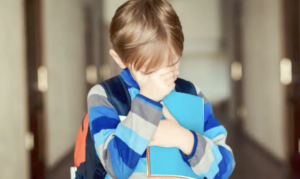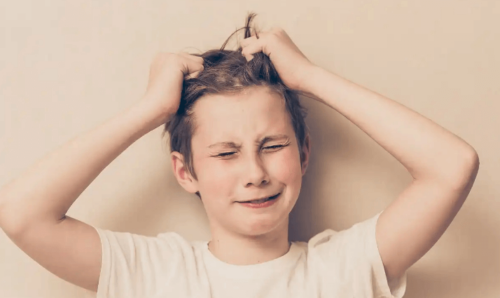Ways to Tell If Your Child is Being Bullied at School


Written and verified by the psychologist Bernardo Peña
Being bullied at school is a common problem today. Because of this, you must be highly attentive to the signs.. Because of this, we must be very attentive to the signs that could indicate that children are suffering from it. Bullying is a behavior of harassment, physical or psychological mistreatment that occurs between schoolchildren repeatedly.
Unfortunately, this type of behavior is becoming more and more frequent. It’s even starting to be seen in class groups where children are between 3 and 6 years old.
For this reason, it’s important to be forewarned and know how to detect the main symptoms of someone who’s being bullied at school as it often goes completely unnoticed.
This is because, many times, the victims feel shame or guilt about what’s happening to them, and are reluctant to ask for help.
Ways to tell if your child is being bullied at school?
From an early age, it’s fundamental to teach your children the values of respect, friendship and trust. It’s also essential that they learn not to respond with aggression if someone does something to them.
They should be aware that they can talk about any problems and express their feelings, doubts or fears with their family members. They must feel free to talk with their relatives, in particular their parents. If you don’t have good communication with your son or daughter, then you’ll never be able to tell if your child is the victim of bullying at school.
Your child could be afraid of telling you or wouldn’t dare mention it at home out of shame. You might also observe certain behaviors that indicate things aren’t going well at school or with your child’s friends.
Behaviors that might indicate your child is being bullied at school

1. A reluctance to go to school
Victims of bullying may fake an ailment to avoid going to school but be perfectly healthy when their parents take them to the doctor. You should encourage your child to explain the reason for not wanting to go. Parents should build trust so that their children feel free to talk about what’s bothering them.
2. Behavioral changes
- These are changes that occur slowly and gradually, affecting your child’s personality. Victims of school bullying may not want to talk with older friends or family, although they used to be extroverted, for example.
- Victims of bullying also get nervous when having to go to school, and their mood changes.
3. Fits of anger, violence, and/or irritability
In teenage boys, it’s sometimes difficult to recognize these behaviors as warning signs because they’re likely to have a quick temper. You must be aware that the trigger for that moodiness might be harassment, however.
Take a look at this article 5 Tips for Raising a Healthy Teenager
4. Missing school supplies or clothing
Your child might start to lose personal items or school materials. Bullies often do this as a way to intimidate their victims.
5. They ask for money
Blackmail is one of the most common practices among bullies. If the child asks for money for expenses they cannot justify or don’t match their consumption habits, they might be giving in to peer pressure.
6. Psychosomatic symptoms
Iñaki Piñuel, an expert in psychological violence and bullying, and professor at the University of Alcalá, explains that the bullying in schoolchildren is psychological for the most part. For this reason, the most common symptom is psychosomatic.
Your child might have different physical symptoms even when the harassment is psychological. Some of the most frequent signs are:
- Sleep disturbances
- Pain upon waking
- Dizziness and headaches
- Tremors and palpitations
- Digestive problems or lack of appetite
7. Changes in school performance
Victims of school bullying might become disinterested in their assignments, and lose concentration and attention.
What to do if you suspect your child is being bullied at school

If you’ve determined that your son or daughter is a victim of bullying or harassment, then the first thing to do is avoid blaming the child or yourself.
- Your child being bullied doesn’t make you a bad parent. Furthermore, the child should feel safe and sound at home.
- Let your child know they’re not alone and can always count on you to listen
- Stay calm. Don’t show concern. Your child needs to see determination, a positive attitude and strength of character.
- Go to the school and talk to an authority figure. That person will help you find the right way to resolve this conflict.
- Communication must be maintained with the school so that you can count on its support and help both the victim and the bully (or bullies) receive a better education about non-aggression.
- At home, place emphasis on tolerance, friendship, and mutual respect to help children grow up into responsible adults. Your home is the main source of love and education for your children. Therefore, it’s there that they’ll learn values and behaviors.
Be aware of this and avoid confrontation, as well as physical and verbal aggression, so that they don’t start to mimic it elsewhere.
Teachers in the face of children being bullied at school
Bullying demands from teachers and the school organization a total commitment to their role as educators, regardless of whether the facts happen inside the school or are unclear.
Their sensitivity and authority will be put to the test in order to connect with students in a climate of trust that allows them to identify and make visible signs and scenarios of harassment and violence.
This reality is even more complex today with cyberbullying and all its terrible variants: grooming, happy slapping, and dating violence, among others.
It’s essential to have the tools and resources at hand to deal with a situation of harassment and, in particular, a protocol that allows to proceed within the framework of learning strategies. This protocol must include the participation of the family and the community in prevention, dialogue and mediation processes.
It’s crucial to understand that bullying won’t resolve on its own. On the contrary, without the prompt and adequate intervention of all involved, it’ll become a bigger problem and lead to fatal consequences for the victim.
All cited sources were thoroughly reviewed by our team to ensure their quality, reliability, currency, and validity. The bibliography of this article was considered reliable and of academic or scientific accuracy.
- Calderón Guerrero, G. (2020). El acoso escolar, la acción docente y la responsabilidad de la escuela. Andamios, 17(43), 345-366. http://www.scielo.org.mx/scielo.php?pid=S1870-00632020000200345&script=sci_arttext_plus&tlng=es
- Dirección General de Familia y Menor. (2007). Atención al maltrato infantil desde el ámbito educativo (Manual para el profesional). Murcia: Consejería de Política Social, Mujer e Inmigración.
- Moreno, R. M. E., Giménez, M. B., & Ruiz, S. Á. (2021). Elaboración de un cuestionario para identificar la formación del profesorado en relación con el bullying. Revista Internacional de apoyo a la inclusión, logopedia, sociedad y multiculturalidad, 7(2), 36-52. https://dialnet.unirioja.es/servlet/articulo?codigo=7973676
- Piñuel, I., y Oñate, A. (2007). Mobbing escolar: Violencia y acoso psicológico contra los niños. Madrid: CEAC.
- Sanmartín, J. (2007). “Violencia y acoso escolar”, Mente y Cerebro, 26: 12-19.
This text is provided for informational purposes only and does not replace consultation with a professional. If in doubt, consult your specialist.








